Many people train their dogs based on theories about dominance, specifically the theory that there is one ultra-dominant alpha among wild wolves leading the rest of the pack. Some trainers give advice such as, “Never allow your dogs in bed with you” or “Always eat before your dogs do” to show your dog that you are the alpha and to assert your dominance. They believe that since beta wolves submit to the alpha in wolf packs, your dog will submit to you and obey you if you show them you are “the alpha”. But is this really the case? Is it a factual, scientifically studied, and evaluated method of training or simply a widely popular fictional excuse for being domineering when training?
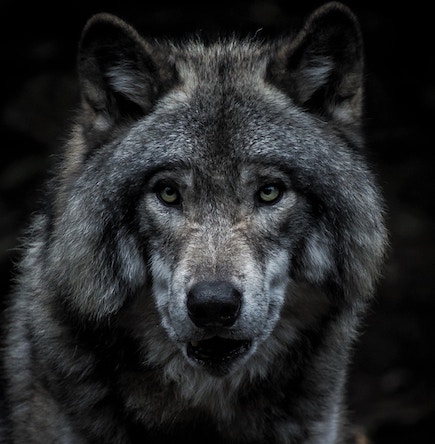
In this blog, we will take a deep dive into the main findings of wolf researchers that led to the alpha myth. Then, I will debunk the alpha myth for two reasons: 1) in wild wolf packs there is not a struggle to become alpha and the wolf that is alpha does not lead in a domineering or dominant way, and 2) even if wolf pack members did regularly seek status, fighting for the alpha position, our modern-day dogs are not simply domesticated wolves. They are more closely related to wild dogs who behave very differently from wolves.
What Exactly Does “Alpha” Mean?
Technically, alpha is the first letter in the Greek alphabet and signifies first. We’ve all heard the terms “alpha dog” and “alpha male” thrown around countless times. When we think of what it means to be the alpha, we think of a group leader, the one in charge, or someone with the most power and dominance. Everyone else in the group is thought of to be a beta, submissive to the alpha.
Where Did the “Alpha Dog” Myth Come From?
In 1970, wolf researcher Dr. David Mech published the bestseller, “The Wolf: The Ecology and Behavior of an Endangered Species”. One of the main topics of the book was the pecking order in wolves, including the concept that wolf packs are led by two dominant alphas, one male and one female. The two dominant alphas were also known as the breeding pair of the pack. These two wolves were thought of to have the most access to resources including food and mating partners. Dr. Mech thought wolves maintained their alpha status by asserting their dominance and fighting off other potential alphas. The other members of the pack had a lower status and were considered beta or omega members, submissive to the alpha. The book was extremely popular with other researchers, the media, and the general public.
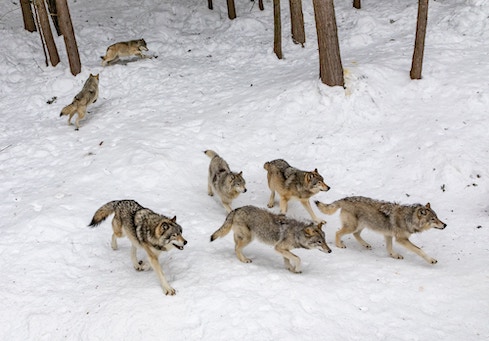
However, years later Dr. Mech realized that his alpha theory was incorrect and spent much of his later career gathering evidence against it.
The main flaw in Dr. Mech’s original research was that it was based on captive wolves. The fighting for dominance that Dr. Mech observed was a byproduct of captivity. Unlike wild wolves, the group of wolves that Dr. Mech observed no longer had to hunt as a family for food. The wolves were provided food rather than hunting which changed the dynamic of the forced “pack.” Since hunting was no longer a part of their everyday life, the need for cooperation and working together was no longer beneficial for the individual wolves. Living in a captive environment, one very different from the one in which wild wolves live, led to more competition and less teamwork.
Additionally, these captive wolves were not related whereas in the wild, wolves in a pack are related. They are formed by parents and siblings, and sometimes aunts and uncles, much like human families. In a recent Scientific American article, Dr. Mech compares the captive wolf environment to that of a human prison. We certainly would not form broad conclusions about the familial structure of humans based on how prisoners interact.
Is There an Alpha in Wild Wolf Packs?
Dr. Mech and other researchers discovered that in the wild, wolves move in families, much like humans do. In the late 1980’s and 1990’s, Dr. Mech completed one of the first multiyear research on a single wild wolf pack over time. He observed an Ellesmere Island pack each year and discovered all members of the pack defer to the breeding male and female–the “alpha” pair.

The once thought of as ultra-powerful, dominant alpha males and females are actually just the parents in the family. These two wolves are not harsh, domineering individuals. However, like two adult human parents, they do have access to the most resources. And, just like any good human parent feeding their infant before their teenager, they give these resources to the youngest members of the pack.
Younger members of the pack follow this couple simply because they are often the oldest pair of wolves and know the most about survival. Younger wolves undergo training and the skills are passed down. Working together as one big family is beneficial for survival as the larger the family, the more likely they are to successfully hunt larger, more difficult game. Cooperation amongst pack members was shaped because it worked for the pack. The more the wolves cooperated, the larger the game they could hunt. Cooperation led to fuller bellies for longer periods of time.
This family structure is not something unique in the animal kingdom. We see similar familial structure in other wild animals too: elephant herds follow a matriarch and orcas follow the grandmother of the group. Nearly all young mammals learn how to hunt and gather resources from a parent. For wolves, having years of experience is what helps the pack survive. There is no need for younger wolves to compete with their parents for dominance. This is incredibly rare and almost unheard of in the wild.
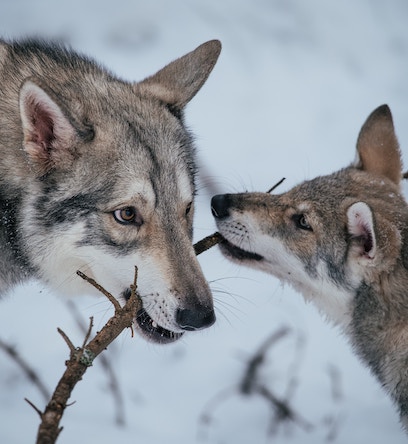
In some unusual cases like in the Druid Peak wolf pack in Yellowstone, there can be multiple breeding pairs in one mega pack. Usually, wolves are groups of six to ten individuals with one breeding pair. The Druid pack reached 37 members and had multiple breeding pairs due to an influx of elk but even in cases of high food density, pack members tend to stick together as it’s dangerous to leave the pack, and food is almost guaranteed when wolves remain in their birth pack. In cases like these, competition can occur amongst breeding pairs over breeding spots but this is incredibly rare per Scientific American.
The notion that there is a singular wolf leading the rest of the pack, fighting with other wolves for dominance and the highest status is simply false. Wild wolf packs typically have a breeding pair leading the pack in a non-dominant way. Wild wolves and captive wolves are extraordinarily different.
Modern-Day Dogs Are Not Wolves
We know that wild wolves do not fight for dominance in the pack, but, even if they did, we can’t assume that our dogs would do the same. In his review of the literature, dog behavioral expert Dr. Clive Wynne reviewed some major differences between wolves and dogs as it relates to dominance and alpha status. He broke those differences down into two major sets of behavior: reproductive behavior and foraging behavior.
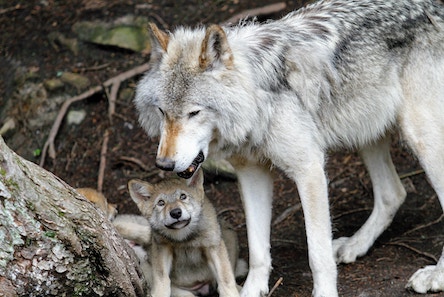
The reproductive behavior of wolves is very different than that of dogs. Wolves form mating pairs for several years, if not for life, and aren’t reproductively active until the age of two. Dogs are reproductively active during their first year of life and typically have multiple partners. When wolves do have offspring, couples work together to raise their young. In contrast, female dogs primarily take care of their young but stop nursing abruptly leaving puppies to survive primarily on their own. Overall, wolves behave much more like a family than dogs do.
The second main difference between the two species is in their foraging behavior. Wolves are hunters whereas feral or wild dogs are scavengers. Wolves share more resources, including food, regardless of their social hierarchy, than dogs do. In order to hunt well, wolves need to work as a collaborative team and cooperate. On the other hand, dogs do not need to rely on each other to eat as they are all scavenging for food, not hunting large animals. Dogs evolved to live close to humans as this behavior was reinforced through continued access to food.
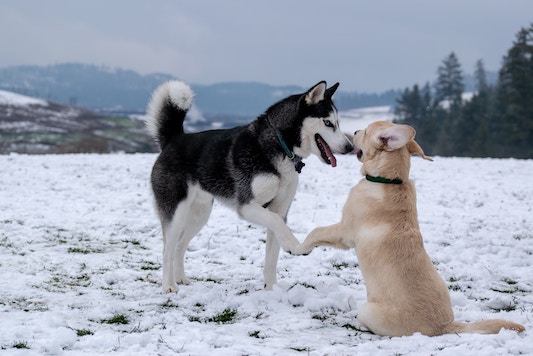
Today, in addition to providing modern-day dogs with food, we control every single one of a dog’s basic needs and resources, including when they can relieve themselves. Dr. Wynne suggests that dogs are able to recognize our high social status and would not want to jeopardize their relationship with us because of how much we control their day-to-day lives.
We human pet parents cannot avoid naturally being “the alpha” in our dogs’ lives. We purchase our dogs’ food, fill their water, and give them shelter. There would never be a time when our pet dogs were responsible for their own primary needs, including finding their own food. Dogs evolved because of their proximity to humans. They are not self-sustaining or hunters.
Per Dr. Wynne’s research, dogs already think of us as having “super dominance” over them so there is no need to engage in aggressive behavior toward them to prove something they already know. As long as your dog’s needs are being met, they are more than happy to automatically slide into a more submissive role. As dog owners, we have an extreme amount of responsibility and power over our dogs inherently and it’s up to us to treat our dogs with respect.
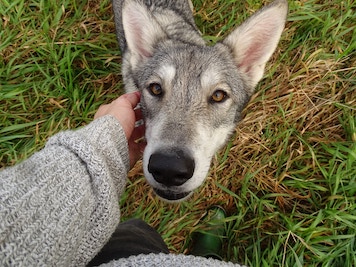
As believers that all dogs are family, we never feel the need to use aversive training techniques inspired by the alpha myth. Have questions about our ethical, science-based training methods? Schedule a free training consultation with us today!




